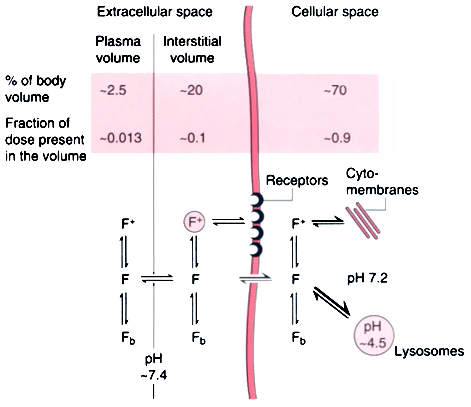 |
 |
Figure 11-12
Distribution of fentanyl within the body compartments
at the extracellular pH of 7.4. The accumulation of fentanyl by the tissue is assumed
to be 13-fold. In the extracellular space, an equilibrium exists between the ionized
fentanyl (F+
), the free base (F), and the fentanyl molecules bound to
macromolecules (Fb
). The concentration of ionized fentanyl within the
interstitial fluid (encircled F+
) determines the pharmacologic effect,
because the opioid receptors are located at the cell surface. Fentanyl as free base
readily penetrates into the cells and becomes bound to cytomembranes, lysosomes,
and other structures (thick arrows) and thus accumulates
in the cell. A small decrease of the extracellular pH will shift the equilibrium
between F and F+
toward higher F+
concentrations and will induce
a marked release of fentanyl from the cellular compartment as a result of the decrease
of the concentration of F in the interstitium. An increase of the extracellular
H+
concentration by pH 0.2 might roughly double the concentration of ionized
fentanyl within the interstitial fluid and accordingly enhance its pharmacologic
effect. (From Lullmann H, Martins BS, Peters T: pH-dependent accumulation
of fentanyl, lofentanil and alfentanil by beating guinea pig atria. Br J Anaesth
57:1012–1017, 1985.)

 |
